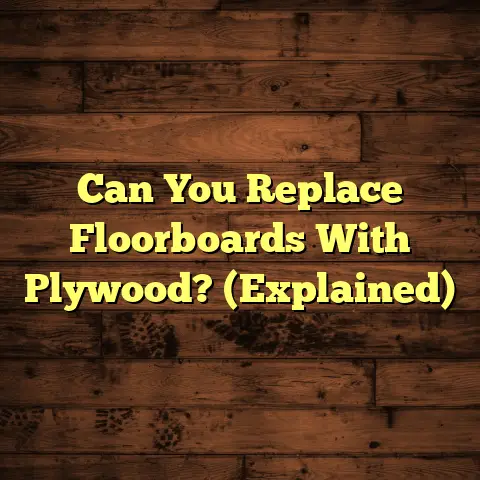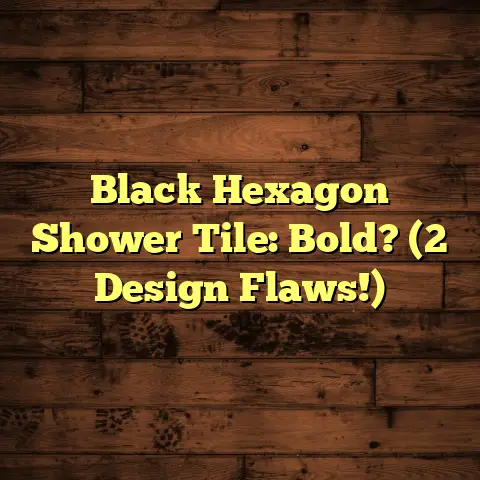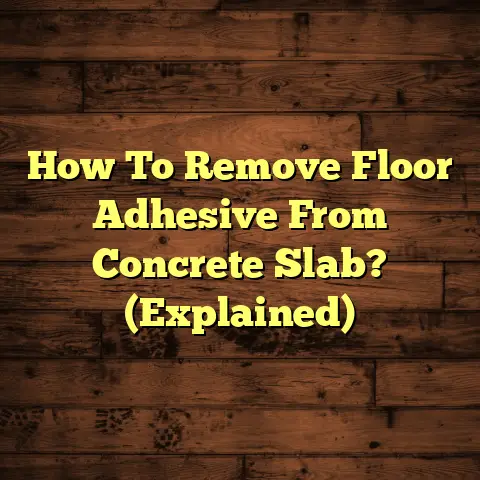Signs It’s Time To Replace Your Hardwood Floors? (Explained)
I remember watching a classic scene from a beloved movie where the main character walks into a beautifully crafted home, and the camera pans down to show off the stunning hardwood floors. It struck me how much of an impact those floors had on the overall ambiance of the space. However, as a flooring contractor with years of experience, I know that behind that beauty often lies the question, “When is it time to replace those hardwood floors?”
Hardwood floors can be the centerpiece of any home, adding warmth and character. Yet, over time, even the most elegant hardwood can show signs of wear and tear. Today, I want to share my insights and experiences regarding when to consider replacing your hardwood floors. Let’s talk about some signs that might suggest it’s time for a change.
Signs It’s Time to Replace Your Hardwood Floors
1. Visible Damage
One of the first indicators that your hardwood floors may need replacing is visible damage. This includes deep scratches, dents, or gouges. I remember a project I worked on where the homeowners had a large dog that loved to run through the house. The scratches were so deep that no amount of refinishing could fix them.
If you can feel the scratches with your hand or see them from across the room, it’s a sign you might need to consider replacement rather than just refinishing. A good rule of thumb is that if the damage goes beyond the surface layer and affects the wood’s integrity, it’s time to think seriously about replacement.
2. Water Damage
Water can be one of hardwood’s worst enemies. Whether from a leaky roof, a burst pipe, or even spills that weren’t cleaned up promptly, water can cause warping and buckling over time.
I once took on a project where a homeowner had a beautiful oak floor that had been severely damaged due to a leak under the sink. Despite attempts to dry it out and fix it, sections of the floor started to buckle. In this case, simply replacing a few boards wasn’t an option. The damage was too extensive, and it required complete replacement.
Understanding the Impact of Water Damage
Water damage manifests in various ways:
- Buckling: This occurs when moisture seeps into the wood and causes it to swell. The boards may lift away from the subfloor.
- Cupping: This happens when the edges of the boards rise while the center remains flat, creating a bowl-like appearance.
- Crowning: In contrast to cupping, crowning happens when the center of the board rises above its edges.
Each of these issues can worsen over time if not addressed promptly. When I assess water-damaged floors, I often recommend a thorough inspection by a professional to determine whether replacement is necessary.
3. Fading and Discoloration
Over time, exposure to sunlight can cause your hardwood floors to fade or discolor. If you notice that certain areas are significantly lighter than others, it might be due to prolonged sun exposure or lack of UV protection.
I had a client who loved natural light and kept her curtains drawn back all day long. After a few years, we noticed a stark contrast between the sunlit areas and those shaded by furniture. In this case, while refinishing could help restore some color, complete replacement offered a more uniform look.
Preventing Fading and Discoloration
To prevent fading:
- Use UV-Blocking Window Treatments: These can shield your floors from harmful sun rays.
- Rotate Furniture: Moving furniture around occasionally helps ensure even exposure to light.
- Consider Area Rugs: Place rugs in high-traffic areas or under furniture to minimize direct sunlight on your hardwood.
4. Excessive Creaking and Noise
If your floors creak or make noise when you walk on them, it could indicate structural issues beneath the surface. While some noise can be normal with age, excessive creaking may signal that the floorboards are no longer securely fastened.
In one instance, I worked on a home where every step sounded like a door creaking open in an old horror movie! After inspecting it, we found that not only were the boards loose, but also some were beginning to split. It became clear that replacing the flooring was the best route to eliminate the noise and prevent further damage.
Addressing Creaking Problems
If you’re dealing with creaking floors:
- Tighten Loose Boards: Sometimes screws can be added to secure loose planks.
- Add Lubrication: A little powdered graphite or talcum powder between boards can help reduce noise.
- Inspect for Underlying Issues: If creaking persists, check for problems with your subfloor or joists.
5. Allergies and Dust Accumulation
Have you ever noticed an increase in allergies or dust in your home? Old hardwood floors can trap dust, allergens, and pet dander within their cracks and crevices. If cleaning doesn’t seem to make a difference, it might be time to consider new flooring.
In my own home, I noticed my allergies flaring up more frequently. After checking for dust accumulation in various places, I realized my old floors were part of the problem. Replacing them not only improved my health but also made my home feel fresher overall.
Tips for Reducing Allergens
To keep your hardwood floors allergen-free:
- Regular Cleaning: Vacuum regularly with a hardwood-safe vacuum.
- Use Humidifiers: Maintaining optimal humidity levels can help reduce dust accumulation.
- Consider Hard Surface Options: Some newer hard surface flooring options are designed to resist dust buildup better than traditional hardwoods.
6. Outdated Style
As trends change, so do flooring styles. If your hardwood floors feel outdated or don’t match your current decor, it could impact your home’s value and aesthetic appeal.
For instance, I once renovated a home with dark walnut floors that seemed overly heavy in a bright and airy space. The homeowners decided to replace them with lighter maple flooring to achieve a more modern look that complemented their style better.
Trends in Hardwood Flooring
Some popular trends I’ve noticed include:
- Wide Planks: Wider boards are very much in vogue and create a more expansive look.
- Natural Finishes: Many homeowners are opting for finishes that emphasize natural wood grain rather than artificial gloss.
- Mixed Materials: Combining different woods within one space creates visual interest and uniqueness.
7. Age of Your Floors
Most hardwood floors have a lifespan of about 20-100 years, depending on care and quality. If your floors are nearing this age range and show signs of wear, you may want to consider replacement as an investment in your home’s future.
I’ve seen many homes with original hardwood from the early 1900s that have been refinished numerous times but are now beyond saving. Replacement offered these homeowners peace of mind and an updated look.
Evaluating Floor Age
To assess how old your floors might be:
- Check Home Records: Look at home improvement records or ask previous owners.
- Inspect for Refinishing Marks: If you see multiple levels of finish buildup or evidence of multiple refinishes, it may indicate age.
8. Cost of Repairs vs. Replacement
Sometimes it comes down to finances. If you’re constantly paying for repairs or refinishing, it might be worth evaluating whether those costs outweigh the price of replacement.
I remember working with a client who had spent thousands on refinishing their floors over several years due to various issues we discussed earlier. When we calculated the ongoing expenses versus installing new flooring entirely, they realized replacement was not only more cost-effective but would provide better long-term results.
Calculating Costs
To evaluate whether repair or replacement is more cost-effective:
- List Repair Costs: Note estimates for repairs needed now and anticipated future repairs.
- Consider Replacement Costs: Get estimates for different flooring options you’re considering for replacement.
- Factor in Long-Term Value: Consider how much value new floors would add to your home versus ongoing repair costs.
How FloorTally Helps
When considering replacement, accurate cost estimation is crucial. This is where FloorTally comes into play for me. It pulls local material and labor rates so I can provide my clients with realistic budgets right from the beginning.
For example, when discussing options for new hardwood floors for my clients’ homes, I can quickly calculate expenses for different styles and types of wood using FloorTally’s tools. It simplifies comparisons between solid hardwood and engineered options based on their budget and needs.
Benefits of Using FloorTally
Here’s how FloorTally has streamlined my workflow:
- Quick Cost Estimates: Within minutes, I can generate estimates tailored to specific projects.
- Visual Planning Tools: The platform allows clients to visualize what different materials will look like in their space before making decisions.
- Waste Management Calculations: It automatically factors in waste during cuts so clients aren’t blindsided by additional costs later on.
Choosing New Hardwood Floors
So now that we’ve identified potential signs that it’s time for new flooring let’s explore how to choose the best option for your home.
Types of Hardwood Flooring
When selecting new hardwood flooring, familiarity with available options is crucial:
Solid Hardwood
- Made from solid pieces of wood.
- Can be sanded down multiple times.
- Offers longevity but can be susceptible to moisture issues.
Engineered Hardwood
- Composed of layers with real wood veneer on top.
- More resistant to moisture than solid hardwood.
- Ideal for basements or areas prone to humidity.
Bamboo Flooring
- A sustainable option made from fast-growing bamboo grass.
- Durable but may require specific maintenance practices.
- Offers unique aesthetic choices compared to traditional woods.
Key Considerations When Choosing Flooring
- Durability: Consider your lifestyle; if you have pets or kids, opt for harder species like oak or hickory.
- Aesthetic Preferences: Think about how different colors and finishes will complement your overall decor.
- Installation Method: Decide whether you’ll hire professionals or attempt DIY installation based on your comfort level with tools and techniques.
- Maintenance Requirements: Some finishes require more upkeep than others; choose based on how much time you’re willing to invest in care.
- Budget Constraints: Establishing an accurate budget early helps narrow down choices effectively without overspending later.
Practical Tips for Installation and Maintenance
Once you’ve selected new flooring, proper installation and maintenance practices enhance longevity:
Installation Tips
- Acclimate Your Wood: Allow wood planks to acclimate in your home for several days before installation; this reduces future expansion or contraction.
- Follow Manufacturer Guidelines: Each brand will have specific recommendations; always adhere to these for optimal results.
- Hire Professionals When Needed: If you’re not confident in your DIY skills or if installation involves complex patterns or transitions, hiring experts is wise.
Maintenance Tips
- Regular Sweeping/Vacuuming: Keeping debris off prevents scratches; use soft bristle brooms or vacuums with hardwood settings.
- Avoid Excessive Moisture: Use damp mops instead of soaking wet ones; standing water can lead to serious damage over time.
- Use Protective Pads: Place felt pads under furniture legs to avoid scratches when moving items around.
- Schedule Professional Cleanings: Depending on foot traffic levels in your home, consider yearly professional cleanings to maintain shine and integrity.
- Refinish Periodically: A good rule is every 5–10 years depending on wear; this restores luster without needing total replacement.
Concluding Thoughts
Replacing hardwood floors isn’t just about aesthetics; it’s about ensuring your home remains safe, stylish, and valuable. By recognizing the signs we’ve discussed, you can make informed decisions on when it’s time for an upgrade.
Every home tells a story through its flooring—make sure yours continues to tell yours beautifully! Whether you’re facing visible damage or simply wanting an aesthetic update, understanding when to take action can save you time and money in the long run.
So next time you notice those little signs creeping in—don’t ignore them! Instead, take a moment to assess whether it’s time for something new. Your home—and your feet—will thank you!





